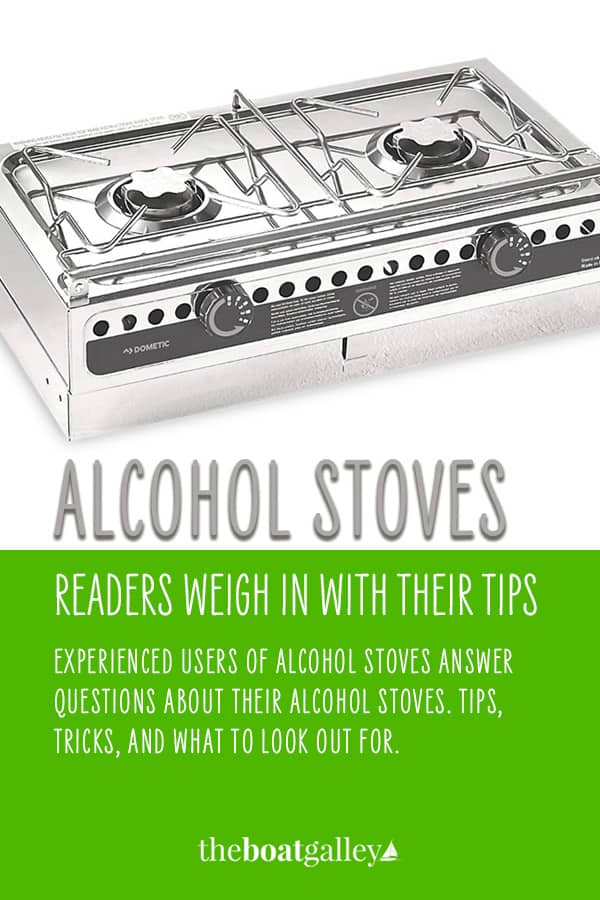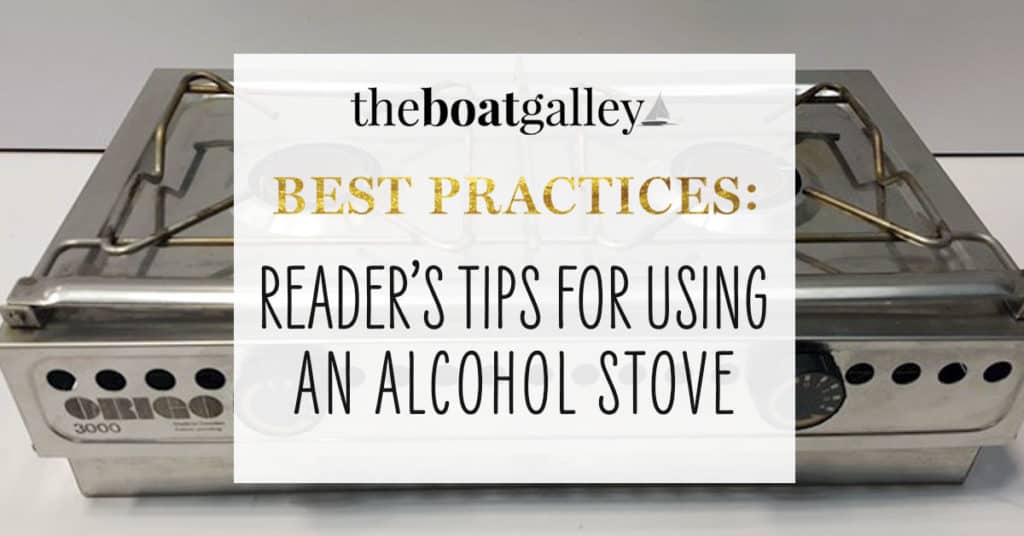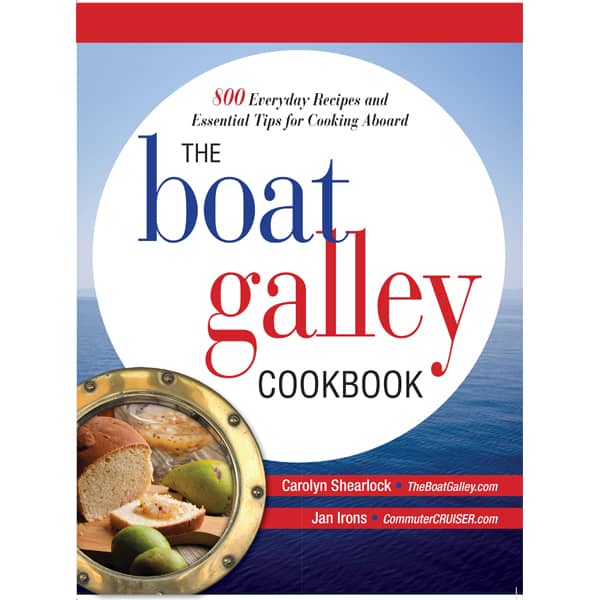
A couple of weeks ago, I got a question from Janice about using an alcohol stove:
We are in the process of purchasing a boat with an alcohol stove. I know nothing about them. I have only had propane. Have you had any experience with this type of stove? I’m curious of its safety and how difficult it is to find alcohol. Also, if there are any difficulties with use. Basically anything you can give me.
Well, I’ve only used one a couple of times, on friends’ boats, and it was over 15 years ago. So I did what I usually do when I need help answering a question: I turned first to TBG readers on Facebook. And they gave me quite a bit of info, which I then supplemented by a few Google searches.
To begin with, most alcohol stoves used on boats are “non-pressurized.” These don’t have to be primed and are considered far safer than the pressurized type. The most popular brand for boats is Origo, and they have several models, including some with an oven.
Let’s begin with what other readers said on The Boat Galley’s Facebook page. I’ve compiled the comments here, editing a bit for clarity:
- Liz Mehrtens We have an Origo and just love it. Not hard to get alcohol. We like the brand at Lowe’s best. Filling can be tricky but there are several tips online that have proven to make it an easy job. [Note from Carolyn: the link Liz gave me was by subscription only, I found the following description but it is no longer available] You can get the Spill Saver device pretty cheaply on Amazon (US) if it’s not available at an automotive store near you (NOTE: one reader reported that this does not fit her metal cans)
- Gina Smith commented on the fact that alcohol stoves just don’t burn as hot as propane, CNG or kerosene and cooking times will be longer.
- Chris Link I use my alcohol oven and stove a lot, easy to get denatured alcohol at hardware, paint and boating stores, even readily available in Marsh Harbor, Bahamas.
- Ritchard Findlay I use my Origo stove all the time. Easy, safe, convenient. I use what we call Methyl Hydrate here in Canada. It’s as Chris says above, available at every hardware store in North America in the paint dept. I pay about $8 a gallon, and that lasts a long time. You can buy stove alcohol at chandleries, but I am really not aware of any true advantage, and it costs 4x as much. If the stove doesn’t have them, find some of the neoprene gaskets that seal the top of the fuel canister when not in use. Otherwise the fuel evaporates quickly.
The most important safety rule is to remove the canisters from the stove to refill. - Al Felker We have used these stoves in the past. Do not get the pressurized alcohol version. They have a bad history of clogging/malfunction/flareups.
Filling the pots is a science. Hold at 45 degree angle while slowly filling pot. When you see fluid at lip, stop filling.
You can also use HEET® brand Gas-Line Antifreeze & Water Remover as well. We have used it many times and is much cheaper as well. - Steven K. Roberts I know in a pinch Everclear works.
- Alan Heaberlin Everclear is a wonderful substitute for ordinary denatured alcohol. You can drink it in a pinch. When I was a backpacker I would carry a small quantity for mixing with Crystal Light, making a nice evening cocktail as well as making the stove roar!
- Radar House Walmart used to sell alcohol in their paint dept…….haven’t bought any in a while…..
No one mentioned it on Facebook, but a small minority of people find the smell that alcohol stoves give off when burning really bothers them.
Another important thing to know about alcohol stoves is that there is typically very little color to the flame. It can be hard to tell when one is lit — or if it goes out accidentally. A friend of mine burned her hand by not realizing that a burner was lit.
A good safety practice is to remove the fuel canisters and fill them away from the stove area — and be sure to wipe up any spilled alcohol. If alcohol spills right near the stove, it can be easy to miss it — and then it can light when you’re lighting the stove. There have been comments about this on my Fire Aboard and Using a Fire Extinguisher articles.
The Origo Operator’s Manual also gives lots of useful information about using an alcohol stove. You can read it and download it (PDF format) here.
And finally, Good Old Boat has a very comprehensive article on its website, comparing pretty much all the varieties of stove fuels and giving many tips about each
Read Next

Carolyn Shearlock has lived aboard full-time for 17 years, splitting her time between a Tayana 37 monohull and a Gemini 105 catamaran. She’s cruised over 14,000 miles, from Pacific Mexico and Central America to Florida and the Bahamas, gaining firsthand experience with the joys and challenges of life on the water.
Through The Boat Galley, Carolyn has helped thousands of people explore, prepare for, and enjoy life afloat. She shares her expertise as an instructor at Cruisers University, in leading boating publications, and through her bestselling book, The Boat Galley Cookbook. She is passionate about helping others embark on their liveaboard journey—making life on the water simpler, safer, and more enjoyable.
Simplify meal prep on board with proven strategies for provisioning, maximizing fridge space, and cooking delicious meals aboard your boat.










Sue says
We only have a 2 burner alcohol stove and a BBQ on our boat and manage cruising the pacific NW for a month at a time. It also works well with my Omnia oven. The smell depends on the brand of alcohol used. We bought some in the San Juan’s last year that was awful. No smell with the Methyl hydrate bought at Canadian Tire. We have the Cookmate brand as the Origo would not fit in our boat and is definitely not as good as Origo we have used in the past
Chad says
We have a two burner origo and use it all of the time. It is slower to cook than other types of fuel as stated above. One of the main safety advantages of using alcohol is that if there is a fire it can be put out simply using water. This is not true with other types of fuel and is one of the reasons it is so popular on a boat.
Gloria Rooney says
I am not a fan of alcohol stoves, having had them, as well as propane which I have now. Although the fire is easily doused, you can easily set a fire that is almost invisible to you with alcohol and also tend to be more complacent with that over other fuels. If you stay with one, I wish you the patience of Job, since it will take a long time to get water to boil. It is a choice, but I do not personally like it and I know of several others who converted to propane after using boat alcohol stoves.
Rhonda Mancini says
We live on our sail boat full time and have used the Origo alcohol stove and oven without any problems. I never had problems getting water to boil unless the canister was nearly empty. We sold our beautiful Taylor kerosene for the Origo due to a lung problem that I have. No problems with odor and we store a year worth on our 34′ where 2 propane tanks should go. To fill, we use my pyrex 4 cup measuring bowl and a large funnel. Hope this has been helpful.
Karen Belinda says
Loved my Origo! “New” boat has propane, and I’m not so sure I like that.
The Sea and Sailors says
I think alcohol stove is safer than propane one!
Brad says
Origio (non-pressurized) when left for a time, can dry out. Not a biggie. An alcohol fire can be extinguished with water when it is POURED, not splashed. Splashing can scatter burning alcohol. Alcohol & water quickly mix, hence out mit the fire. Kerosene, LPG, CNG fires need an extinguisher. I’ve a pressurized alcohol stove for 15 years, summer cruising use. No problems. To use one, the remotely located tank containing alcohol gets pressurized – I use a bicycle pump. Then the burner is opened slightly as if being turned on. Watch it, as liquid alcohol is fed into the burner, usually there’s a gurguleing sound. It then will be expelled from the burner, and drip into a cup/plate below the burner. The cup/plate is part of the burner assembly. Turn off the burner to stop the feeding of liquid alcohol once a very small puddle is in the cup. Light the cupped liquid and watch the resultant flame – it will burn a few inches above the burner. Let the flame burn down, a few minutes- it is heating the burner – and before it has burned out, slowly open the burner. It will hiss as the pressurized liquid alcohol from the tank hits the hot burner. This effectively turns the liquid to a gas by heating it. The gasified alcohol is what burns to heat your pots/food. If the burner flares, orange/red, as it is turned on, rather than looking like a gas stoves burner’s blue flames, it has not been heated enough. Turn off the burner, and let the cupped liquid burn more. Open the burner again but if it flares again, it has not heated enough so you may have to start over. Once there are small, mostly blue flames coming from the multiple holes of the burner when opened, it is ready to use and any cupped liquid will slowly burn away as you’re using the burner. Should you turn off the burner, it can be re-lit while it is still hot, but not once it has cooled. Simply repeat the heating process.
Hint (cheap me), I put a pot of water onto the burner while the cupped alcohol is burning 1) to heat it (for dish washing) while also heating the burner, and 2) to have water at the ready, should I need to douse, by pouring, onto any excessive initial heating (burning) alcohol. In 15 years, this was needed but once as I was distracted and did not notice that my cup runneth over (the burner heating phase). The same procedure is used when working with a kerosene (pressurized) stove. Drip, ignite, heat burner, turn on. Remember to keep the tank pressurized, using a few pumps from the bike pump (some tanks have a self contained pump -its maintenance is another story).
Joe May says
Thank you for the excellent instruction on the use of an alcohol stove. My alcohol storage tank is a metal canister bolted to the bulhead inside a lazarette. There is a cap on the tank wherre it appears that a bicycle pump with a valve stem could be inserted to presurize but some sort of calking material was inserted in the opening – to close it and stop evaporation i am guessing. But that, of course, makes it unuseable. So, to my question, do you have any idea where I can acquire a replacement filler/presurization cap?
Thank you
Jerzyjoe
Carolyn Shearlock says
I don’t but maybe someone else will. Watch out with the pressurization!
Robert Groves says
We live in the north & there are no boat supply stores close. I have had Capt Phab delivered but it is not cheap. Do you know if the bio fuel ethanol sold at Canadian tire is suitable for these pressurized boat stoves? Looking for a local source for fuel.
Carolyn Shearlock says
I don’t use an alcohol stove myself, but I am quite sure you don’t want the ethanol due to the fact that it is an explosive fuel. I don’t know if it would be any cheaper than the Capt. Phab, but you can use very high proof (drinking) alcohol, such as EverClear (the 190 proof is better than the 151, if you can get it).
Myron says
??? Ethanol (C2H6O) is grain alcohol as is EverClear.
Carolyn Shearlock says
Where I live, people call gasoline with ethanol just “ethanol” and that is what I was thinking of.
Melanie says
ethanol is just alcohol, it’s not explosive. Ethanol stoves are the safest stoves made outside of electric
Carolyn Shearlock says
I guess I was thinking of “ethanol” as shorthand for “gasoline with ethanol” as that is typical usage where I live. And gasoline with ethanol is definitely explosive! Yes, the ethanol by itself is alcohol.
Richard H Kokemoor says
Thanks for defending the alcohol pressure stove. I bought an old one cheap, with the intention of converting it to kerosene, but the jets (too large for kerosene) are brazed in rather than screwed in as with kerosene pressure stoves, so that was out. I experimented with the stove as is and found it to burn as hot as kerosene, though presumably consuming more fuel as the energy content of alcohol is lower. The oven will reach an indicated 500 deg F. The burners also preheat quicker than a kerosene pressure stove.
If like me you are leery of the explosive potential of propane stoves but want something hotter than a non-pressurized alcohol stove, this is a real alternative. Unlike the kerosene pressure stove, no separate fuel for priming is required. Alcohol fuel is rather expensive by the gallon, but much cheaper if you can get it in five gallon cans.
Andy Campbell says
No offense but that sounds like a royal pain in the butt, and dangerous. The idea of trying to calmly “pour” water over a raging alcohol fire when this goes bad so as to avoid splashing or dousing with water abruptly and spreading the fire just sounds terrifying. I don’t really see being able to put out an alcohol fire w/ water as any sort of advantage. Yes pulling the pin on a fire extinguisher will result in a mess, but I’ll be alive and my boat won’t be burned to the water line. bottom line when my boat is on fire, I don’t want to have to worry about being “careful” in putting it out, I just want the damn fire OUT.
No wonder my mom hated the alcohol stove my dad purchased for our boat when I was a kid. My dad wouldn’t have propane on the boat for fear a leak would result in a collection of propane in the bilge, a hidden propane bomb waiting for a little heat to set it off. My father was a smart man and I don’t recall him being overly cautious, just practical. I’m sure this was likely a valid threat in the 70’s. Propane plumbing and containment systems are better now, not to mention the required shutoff systems.
A about a year ago, some YouTubers had an alcohol stove accident on their vessel which resulted in some pretty serious burns to one of them. In my opinion, I just think propane is the better option…but we can’t be complacent with any fuel we carry on our boats, they all have the potential to do the worst thing imaginable.
Carolyn Shearlock says
A fire blanket is an even better option. See more.
Mark says
I bought my stove used and it was missing the gaskets which cover the alcohol canisters. I found that rubber sink stoppers work well and cost a little over $1. Look for one without a gripper-tab which can prevent a good seal.
Also, I have read that the cheapest place to buy fuel is at the Dollar Store where it is sold as fondue fuel.
Kelli says
Just wondering if anyone has any tips on avoiding the black soot on your pots and pans from the alcohol stoves? I have been trying to research this but haven’t found any answers. I love our stove but I hate when everything gets black. Thanks in advance!
Brad F says
I’ve an ancient (1968) pressurized alcohol stove and I’ve not any soot problem, so this does not answer your question. I do have a problem from my diesel engine’s exhaust which coats my boat’s transom with soot. A squirt of Tide cloths washing detergent on a rag cleans off the soot. Not a solution but it might clean your pots/pans easily.
Carolyn Shearlock says
I asked your question on The Boat Galley’s Facebook page and any responses will be imported here 🙂 -Carolyn
Dave Skolnick (S/V Auspicious) says
Soot is a product (along with carbon monoxide) of incomplete combustion. That can be the result of poorly designed burners but is more likely to be dirty burners. Disassemble everything and clean thoroughly with a good solvent. Try again.
Once you have soot on your pots the only thing that has worked for me is detergent and bronze wool. Don’t use steel wool or any of the store bought soap soaked variants.
Becky says
To prevent black sooty pots wipe them down with liquid dish detergent before cooking. Washes right off!
Graeme Lockie says
Hi there. I realise your question was posted quite some time ago but I’m pretty sure I have your answer. You have been using the wrong alcohol. Never use anything other than denatured alcohol otherwise known as methyl hydrate. You can buy it in the paint sections at hardware stores. In a pinch you can buy Heet from a gas station which is methyl hydrate. Only buy the Heet in the Yellow container. The other one, I think it’s in a blue or red container will cause the same sooty problems.
Methyl hydrate burns hot & clean. I have never had an issue with soot from it. Any other type of alcohol will burn with smoke & blacken your pots & pans. Remember: only use methyl hydrate/denatured alcohol for an efficient clean burning stove. Never, ever use any other type of fuel such as gasoline or kerosene as it can be very dangerous & explode. The rubbing alcohols, even the 99% versions will smoke when burnt & blacken your pots & pans. Don’t bother with fondue fuel or lamp oil. I trust this has helped even after all this time. Cheers & bon appetite.
Carolyn Shearlock says
You’ll have helped plenty of future readers, too — thanks!
Martin F says
Actually, denatured alcohol (aka methylated spirits or meths) is ethanol plus a small amount of either methanol or propanol. Ethanol — the alcohol found in drinks — burns hotter than methanol but is more expensive.
Keith M says
What I found online. It looks as though the denatured alcohol is the best option price-wise and is almost identical to marine stove fuel with the exception of the 1% xylene, not enough to be concerned about causing health issues.
Methyl, Ethyl, and Isopropyl are chemically similar and with the exception of Isopropyl most alcohols are just a mixture of methyl/ethyl. For example the denatured alcohol you buy at hardware stores is 89-90% ethyl 10% methyl >1% xylene
yellow HEET is +99% methyl >1% xylene.
Everclear alcohol is 90-99% ethyl 1-10% water.
Marine stove fuel is 90% ethyl 10% methyl.
Methyl and Ethyl are so close in structure they both provide nearly identical caloric energy when burned with only a slight advantage going to Isopropyl which has slightly longer carbon chains but also causes it to soot up more when burned. For the most part the main factor in buying stove fuels is the cost since you’re basically buying the same ingredients but in different packaging.
The Boat Galley says
The only “trick” I know is from wood fires with Scouts . . . wiping the outside of the pan with dish soap before putting it on the fire. But that just makes it a little easier to clean, doesn’t really avoid the problem.
Joe Sprouse says
I second this. Dish soap an old boy scout technique.
Patricia Bryk says
Haa haa I was going to write about the dish soap trick too!
Tammy Swart says
Try baking soda and peroxide paste.
CaptRich Kervan says
I use marine grade alcohol in my Origo and have never had a problem.
Liz Mehrtens says
have an origo also and use denatured alcohol i but at lowes and never have a problem. some alcohols are certainly better than others. is it a pressurized stove?
CaptRich Kervan says
No…my Origo is not pressurized. I started out my sailing journeys using an Optimus pressurized stove. I sort of became an expert on them. One year…I started a cruise using hardware store alcohol and it wouldn’t even vaporize. I had to wait a couple of days to get to a Marine store. I learned my lesson. The extra cost of marine alcohol is well worth it. Burns hotter also.
Jacqueline Carlsten says
Same here with my Origo once I switched to the right alcohol
Kevin Budde says
One way to look at it is this, instead of seeing it as s problem, consider that the darker surface will heat more quickly, which will make them more efficient.
Or scrub them shiny, your call. Just trying to save you a bit of fuel & a lot of elbow grease. 😉
The Boat Galley says
But the carbon gets on everything it touches . . . so not really a good solution to “just leave it.” :/
Kevin Budde says
Fair enough
Dave Skolnick says
The carbon is an insulator. Not good.
Allan Cobb says
The soot is coming from incomplete combustion of the alcohol. This could come from the fuel being used or from restricted jets on the burner. Try changing fuel or cleaning the burner jets. If the problem is from burning bad fuel, the jets on the burner may be dirty (sooted up) too.
If you are using denatured ethanol (like you should be using) you can test your fuel by burning a small amount in a dish and see if any residue is left behind. Some brands (and even some batches) are better than others.
Kelli Chater says
Thanks for the info. We bought our fuel from our local Marine store and then checked with another Marine store and they sold the same kind so I’m assuming we have proper marine fuel. I will double check our supply though just to make sure. We won’t be boating until the spring but we’ll refer back to this info and see if it helps.
Allan Cobb says
Clean the burners and that should solve your problem.
Allan Cobb says
A quick test to see if it is the stove is to buy a small bottle of Everclear and try using that as fuel. If you still have a soot problem, clean the burner jets. You can get creative on how you use the rest of the Everclear.
Joe Paul says
We love our Origo stove, but have found that the percentage of additives in our Denatured Alcohol fuel vary by brand – one company even changed their formula to increase their additives! (We use Kleen Strip SLX) I researched the MSDS on a list of brands and here is the result:
2015 Denatured Alcohol (Stove Fuel) comparison:
material safety data sheet (MSDS)
PERCENT ETHYL ALCOHOL (HIGHER IS BETTER) / PRICE PER GALLON
ACE: 43%
CROWN: 20%
EVERCLEAR: 95% / $75
KLEEN STRIP SLX: 45% / $18
KLEAN STRIP GREEN: 85% / $28 ($7 per qt)
JASCO: 43% / $16
SEAFIT (West Marine): $18
SUNNYSIDE 834G1: 43% / $15 (formula used to be 85%)
CAPTAIN PHAB MARINE ALCOHOL: 90% / $24US (Buy in Canada)
Cathy Colley says
Back in my girl scout days, we put liquid dish soap on the bottom not to prevent them from getting black but to make them easy to wash it off. Not sure if it works on alcohol stoves!
Dave Skolnick says
I agree with Allan Cobb – here is what I posted on The Boat Galley:
Soot is a product (along with carbon monoxide) of incomplete combustion. That can be the result of poorly designed burners but is more likely to be dirty burners. Disassemble everything and clean thoroughly with a good solvent. Try again.
Once you have soot on your pots the only thing that has worked for me is detergent and bronze wool. Don’t use stell wool or any of the store bought soap soaked variants.
Kelli Chater says
Ok thanks for the info. As indicated in my reply to Allan I am pretty sure we are using the right fuel as we buy it from our local marine store. But we will clean it and try again.
Rebecca Hammond Vaughan says
I had this problem with my propane stove and once I cleaned the burners and components thoroughly, all good, no soot!
Julie Anderson says
Metal Wax??
Julie Anderson says
Barkeepers Friend??
Molly Stokes says
An old camping trick is to rub with dish detergent before usinf on campfire. Not sure if safe on her stove.
Ted Graves says
coat the bottom of the pans with soap. . .
Marc Sidell says
Dish soap on the bottom and it cleans up nicely after
Heather White says
Steel wool pot scourer
Kelli Chater says
Thanks for all your comments everyone! We will try cleaning the burners as indicated by some of the members below. We buy our fuel from our local marine store so I am pretty sure we have the correct type. Also, I can always get the soot off the pans it’s just a pain because the black sometimes transfers to other areas of the boat when I start cleaning it off.
Diane Dashevsky says
Carolyn, you took the works right out of my mouth…or fingers..as the case may be…was also going to suggest soap from scouting days. Worth a try…it may work. For tough cleanups, cream of tartar works well as does the commercial product Dawn Power Scrubber.
Jacqueline Carlsten says
I use steel wool and spar cream when I get a little black on the pots comes right off
Karin Ulrich says
The problem might be the brand of alcohol you use, we buy ours at ACE. My pots are only have a smudge of black
Silvana Skoko Donald Stiff says
Try Mr. Clean Buddy magic eraser. I was able to clean pots, pans and the oven too.
Pye Hope Simpson says
Does it make any difference the type of pan you use with an alcohol stove? Is it better to use light weight (enameled) aluminum for heat transfer or heavy duty Dutch Oven type or any other type? What tips, suggestions, advise does any one have about using a pressure cooker? Thanks.
Kelly Brown says
The pour spout linked to Amazon in the first post doesn’t fit the metal gallon alcohol jugs. $3.95 down the tube.
Does anybody know of a screw on spout that does fit? I’ve tried the auto part stores and big box lumber.
Carolyn Shearlock says
I’m sorry to hear that it didn’t fit yours. I added your comment to the post. Hopefully someone will have an answer for you.
Sarabi says
Does an alcohol stove like this, if used in a house, need to be vented? I am off-grid and would like to use one in the house, does it require traditional venting like a range hood?
Thanks kindly, useful article indeed.
Henry Olsen says
“May I Please” ask a question? I was given an Origo 3000 that came off of a boat after hurricane Harvey caused the boat to fill with “rain water” which in turn got the stove wet. All fresh water. Is it possible to dry the wick material in the containers? Thank you most kindly for allowing me to ask!